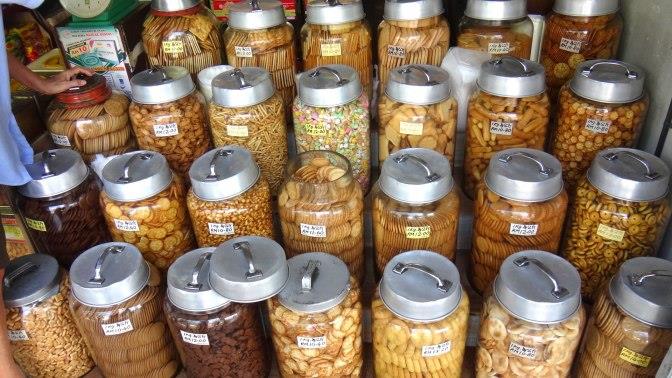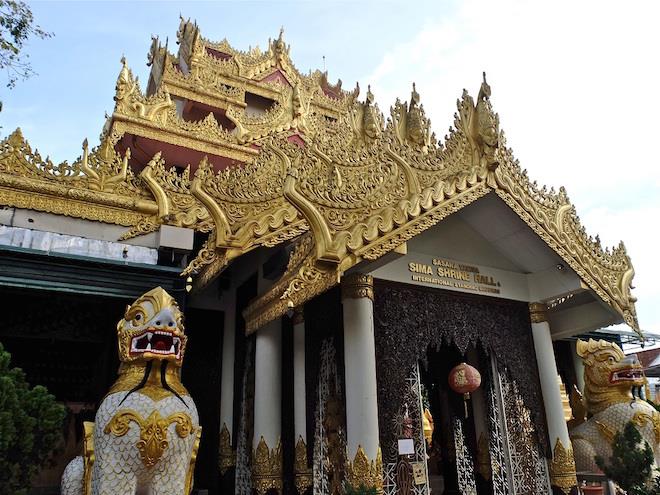Wat Chaiyamangkalaram
In 1845 the British authorities granted a piece of land to Penang’s Siamese community as a gesture of goodwill and to encourage trade with Thailand. The Thai Buddhist temple was built soon after. The original main shrine of Chinese-influence structure stood serving for 88 years before a renovation that made it into what it is today of modern Thai Buddhist architectural style consisting of intricate details and upward flicks of its roof but the golden pagoda kept its original design and structure. When completed in 1910, a loog nimit, which is a consecration and laying of sacred stones ceremony, was performed and the sacred stones were buried beneath the little pagodas around the shrine and pagoda. In the hall next to the main shrine, lies the largest reclining Buddha statue in Penang at 35 metres in length and the third largest in the world. The statue was built in 1958 and it’s gold-plated. A joint Thai-Burmese cemetery lies behind it where you can see graves built with different cultural influences.
Church of the Immaculate Conception
This Roman Catholic church is the second oldest in the diocese. It was founded in 1811 by the Thai-Portuguese Catholics from Phuket and Kuala Kedah, who fled from Phuket to avoid Catholic persecution during the leadership of Father John Baptist Pasqual. Father Pasqual first set up his church in a Tent with the dead buried around it, on land that is now the Kelawai Road Catholic Cemetery. In 1819, he built a wooden chapel covered with attap leaves on exactly where the church is currently located, and served as the proper Church of the Immaculate Conception until 1835 when it was replaced by a Portuguese-style brick building. After which, due to a collapse of its ceiling, it was rebuilt in 1899 in Gothic architecture. A renovation done to it in 1960s altered its façade considerably to what it is today. Efforts to conserve this historical building resulted in a recent round of conservation work in 2014.
Kampung Serani
The early Thai-Portuguese community donated lands to build the first building of Church of the Immaculate Conception which was made of planks and covered with attap. The neighbouring land had a considerable 150 resident-sized Eurasian village named Kampung Serani and managed by Catholic parishioners. Then, villagers young and old helped with chores and took part in religious activities. Houses were made of wood with zinc roofs. A building that resembled a ship called Noah’s Ark in which the first school in Pulau Tikus sat was considered the largest structure of the village. Unfortunately, Kampung Serani had to give way to development in 1980s. Today, Bellisa Row arcade and Bellisa Court stand on the site of what was Kampung Serani and only street signage bearing Eurasian names such as Leandros Lane and the building at the end of Solok Serani that houses The Penang Eurasian Association are reminders of this early Eurasian community in Pulau Tikus.
Burmah Road
When Francis Light came to Penang in late 18th century there was already a Burmese community in Pulau Tikus. Burmah Road was a small road that cut through plantations to their settlement known as Kampung Ava. Today, it’s one of Pulau Tikus’ main commercial roads where traditional shops offering daily necessities, Chinese medicine shops, old-school laundry service and motorbike repair services, sit. Here, Ban Joo Lee grocery store welcomes you with large glass jars and aluminium tins of biscuits sold by the pound and Lay Seng bicycle shop where 81-year old Uncle Ah Kow has been fixing bicycles for over 60 years. His children have now expanded the business to a motorcycle shop across the road. Side by side with cafés and restaurants are pockets of hawker stalls and Chinese coffee shops peddling Penang favourites.
Bangkok Lane
This small road neighbours the Wat Chaiyamangkalaram and where the Thai and Burmese communities settled in Penang. In 1928, the late multi-millionaire Cheah Leong Keah built 41 double-storey houses for his family that lined both sides of Bangkok Lane, lending it a beautifully symmetrical layout and the two houses on the corner facing Jalan Kelawai were the main family homes. Bangkok Lane was a leafy lane fringed by trees under which children used to spin tops, shoot marbles, play hopscotch and fly kites. Now, many of the Cheah descendants have moved out of these houses over the years but the family still manage the houses through a family trust. The houses’ architecture style was influenced by both east and west in the Straits-Eclectic fashion. Today, it’s a quaint street where cafés, boutique hotels, small clothing stores and an art gallery flourish.
Pulau Tikus Market
This morning market and the area that surrounds it is popularly known as the ‘rich man’s market’ because of the higher quality products on offer such as a wide range of fresh local produce such as fresh meat, seafood, vegetables, spices, fruits and dry goods. It sits in a building erected in 1955 and inside, there is a food court too. A neighbourhood arcade next to it, Marble Arch, is the place to find artisan products such as sauces, clothing, various Chinese medicine and toys as well as a chic café while outside are pop-up stalls selling vegetables, clothes, kitchenware, artisanal Penang foodstuff such as acar, Nyonya kuih and live plants. In nearby Chinese coffeeshops, there is a host of hawker stalls serving local breakfast of Chinese noodles, chicken rice and apom. As evening dawns, it morphs into a bustling food court with a myriad local food such as lok-lok and laksa.
Kampung Siam
Captain Francis Light noted in a letter dated 1793 to the government of India in Bengal, the presence of 100 Burmese and Siamese in Penang. In an 1828 census, a total of 1,117 Siamese and Burmese were recorded on Penang island, majority living in Pulau Tikus. The area where the Siamese settled is called Kampung Siam. Then, life revolved around Wat Chaiyamangkalaram where monks taught the village children and walked into town to collect their daily alms while adults helped with chores around the temple. Male villagers joined as monks temporarily at the temple, villagers performed the Thai dance Menora during temple festivals and grew medicinal herbs to produce remedies sold by traditional doctors who were a majority of the village’s population. Now, a few Siamese families remain in this village but they kept the Thai tradition alive through Menora, musical instruments and the Thai language.
Kampung Syed
It’s also known as Kampung Arab or Kampung Coopee Ammah where the Arab community settled. In 19th century, Syed Mohamad bin Syed Abdul Rahman Alhabshee from Kedah bought the land for 500 Spanish dollars and on 24 Feb 1875, his wife Ku Pahmah endowed the land to her son as an official trustee. The land, later referred to as Coopee Ammah Wakoff, covered an area of 142,417 square feet. In 1936, the trustees handed over the administration of the land to the Mohammedan and Hindu Endowments Board. Then, the village had seven houses. Now, it has 23 houses that are still homes to the descendants of Ku Pahmah and her husband. House number 196 used to be the official residence-cum-family court of the kadhi where Muslims went to for matters such as marriage, divorce and such. Today, the Arab influence is evident on post boxes marked with house number and residents’ names, where men bear the name Syed and women, Sharifah. Houses are passed down to only members of the same clan and there’s a historic graveyard of buried deceased clan members.
Dhammikarama Burmese Buddhist Temple
It’s the first Theravada Buddhist temple on Penang island and founded on 1 Aug 1803. The stupa was declared sacred in 1805 and it’s enshrined within an outer stupa built in 1838 with the adjacent ceremonial Sima hall. It’s also known as Nandy Moloh Burmese temple because the land on which it sits was purchased by Nonya Betong for 390 Spanish Dollars and donated to the temple. Restoration of the temple was done the last three decades and has many shrines and statues now. Some of its remaining historical features are the pagoda and temple well. Its Sasana Vamsa Sima Shrine Hall was built in 1995 with a large standing Buddha statue in the centre, replacing the old one built in 1838. Other shrines on the premises include Arahant Upagutta built in 1840 which was a simple wooden structure on stilts in the middle of a small pond but was replaced by a brick building with a multi-tiered roof in 1970s. Also, a majestic four-story golden pagoda bell tower opened in 2011 that has carved drawings on marble slabs depicting monumental Buddhist shrines from 22 countries. It was listed as one of Penang’s historical site in 1988.
Kampung Sirih
This Chinese village of Pulau Tikus got its name from the betel nut or sirih plantation that existed in the early 20th century. The betel nut leaf was much sought after by the Siamese and Burmese who either chewed the leaves or consumed in meals. The betel nut plantation declined over the years due to lack of demand. Today, Kampung Sirih is half the size of what it was due to development of modern housing estates but it retains the charm of village life. There’s one surviving betel nut plant in Solok Codrington, behind Kuil Sri Muniswarar. The leaf is a close relative of daun kadok that grows in abundance here and is an ingredient for Nyonya dishes like perut ikan and otak-otak. Along Lengkok Burma, there’s a food court that’s popular with the lunch crowd. Hong San Tai Ong temple is where people get together for festivals such as the Hungry Ghost.
Kuil Sri Muniswarar
More than 70 years ago, the Tamil Hindu community from Kampung Sirih established this temple. They were mainly coconut plantation workers, fishermen and petty traders but the community dispersed due to the demolition of Kampung Sirih in 1970s. It was a simple wooden shed built under a Bodhi tree but became the current structure that incorporated the tree inside it. A vegetarian kuil, it is dedicated to a powerful Hindu God called Muniswarar, whose main weapon is a trident. He sometimes worshipped in a form of a trident with limes placed on the prongs of it. Today, even the Chinese folk from its vicinity come to pray to God Muniswarar as well as patients of nearby hospitals seeking good health and a speedy recovery.



DISCOVERING PULAU TIKUS, ONE GEM AT A TIME
The Heritage Hunt 2015 is designed for you to discover these heritage sites by foot. Explore these heritage and cultural sites while completing fun tasks and puzzles together, and stand a chance to win a prize in a lucky draw. This is a chance to spend quality time with family or friends while learning about the history, culture and heritage of Pulau Tikus. Details below.
Event date: 11 Oct 2015
Time: 8am – 1pm
Venue: Pulau Tikus
Start & assembly point: Balai Rakyat Cantonment Road (30 mins before)
Registration URL: https://event.howei.com/event/hh2015
Registration form: Pusat Khidmat KADUN Pulau Tikus at 34 Jalan Jones in Pulau Tikus
Registration type: Group/teams of 3-5 participants
Registration fee: RM200 per group/team
Registration Close: 4 Sept 2015
Image credits: Leonard Selva